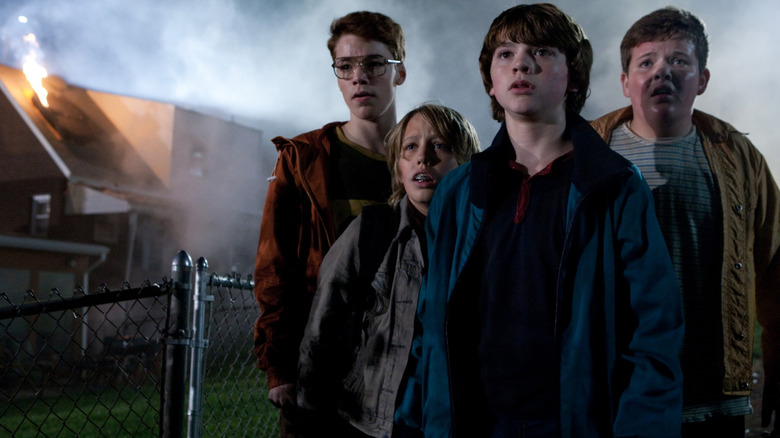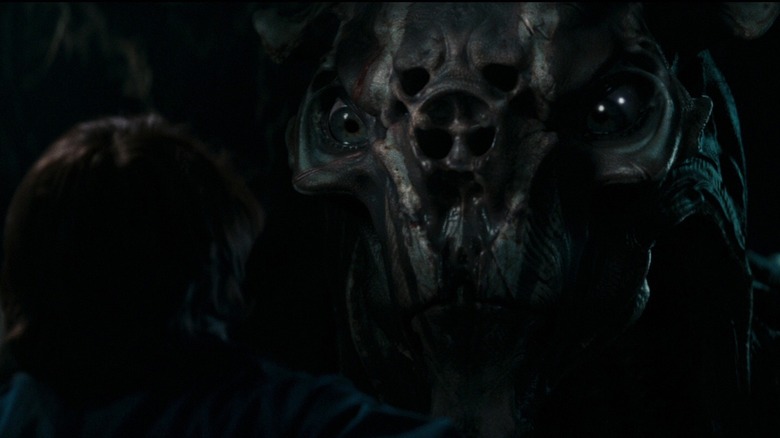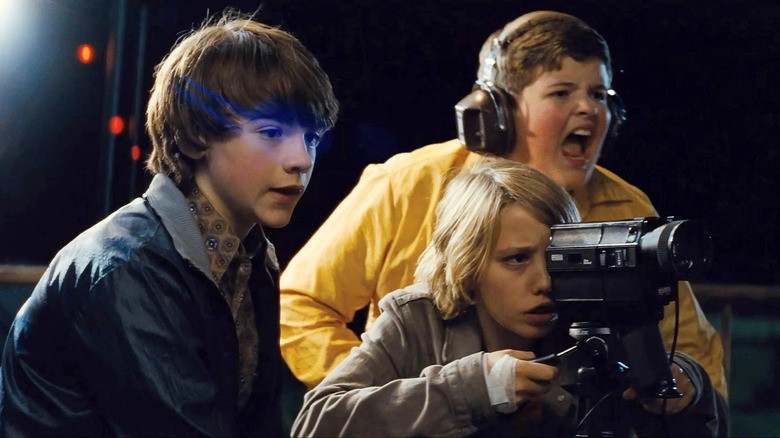J.J. Abrams Took An Unusual Approach To Super 8's Creature Design
J.J. Abrams' 2011 sci-fi film "Super 8" is an unabashed homage to co-producer Steven Spielberg's own "E.T. the Extra-Terrestrial" as well as to the myriad "E.T." knockoffs that followed it throughout the '80s. Set in the very early 1980s, "Super 8" is about a quintet of 13-year-old Goonies who are busy making their own amateur zombie thriller on consumer-grade Super 8 cameras when they run afoul of a local military conspiracy hiding something from the public. It's pretty clear from the start that the secret is a space alien. The local Ohio town has been experiencing electrical and magnetic disturbances of extraterrestrial origin, and the film's lead character, Joe (Joel Courtney), begins experiencing a very E.T.-like psychic link to an off-screen life form of some kind.
The actual alien doesn't appear on screen until the film's climax. The alien is not an adorable, kid-sized critter like in Spielberg's movie, but a massive, spindly monster with many long bony limbs, threatening eyes, and multiple nostrils. It had been trying to flee Earth ever since crash landing some 25 years before, and the main kids in "Super 8" were there to witness its freedom.
The nameless alien was designed by Neville Page, a 20-year veteran of the industry who has worked on creatures and character designs for Tim Burton's "Planet of the Apes," "Cloverfield," "Avatar," "Prometheus," and Darren Aronofsky's "Noah." He's also behind the creatures on "Star Trek: Discovery" and "Star Trek: Picard."
In an interview with Dread Central, Page talked about how the alien design for "Super 8" was arranged backward from the usual way of doing things. That means the production designer assembled the alien's underground lair prior to the design of the actual alien. The creature had to match the environment and not the other way around.
When the feet match the floor
Logic would dictate, of course, that the alien be designed, and then machines and tools be designed to fit to its biology. By inverting that process, Page essentially became an archeologist, speculating what kind of species would occupy the chairs and environments that production designer Martin Whist invented. Not only was this difficult, but Page had to wrap his mind around an imaginary animal that was both lumbering and meticulous. In Page's words:
"The design process on 'Super 8' was what I would call the 'cart leading the horse' approach. We had to design the creature at the same time [Whist] had to be creating these environments for the alien — like the underground lair — without even knowing yet what we were designing. Then there was this wish list of things the alien should have that were juxtapositions in design; the creature had to be extremely large but it had to have dexterity within its limbs to grab things like car engines and microwaves and then assemble them, so that was a design challenge in itself."
The final design was only vaguely humanoid, with two leg limbs, four arm limbs (the creature had a secondary set of shoulders extending from its back), and an elongated, flat head atop a barrel-shaped torso. The creature's legs split at the shin, leading down to a pair of hoof-like feet on each leg. The hooves were, in Page's mind, an evolutionary development intended for digging, and Page figured his creature would be comfortable underground. By lucky coincidence, Whist had already designed an earthen floor for the alien's lair, making the two design departments temporarily copacetic.
Pretty little alien eyes
Page recalls, also, that Abrams had a very specific decree when it came to making the alien: It had to have a relatable, human-enough face. The creature, in short, couldn't be so unusual that its emotions couldn't be read by the human audience. This all came down to the creature's eyes. Common wisdom dictates that a creature with small, beady, unreadable eyes would be seen as sinister, while a creature with large, round, open eyes would be seen as friendly. Abrams likely didn't want the former, and it's possible to push things too far in the latter; one doesn't want a cartoon character. Page feels like he struck a good balance, although is modest as to whether nor not he was entirely successful:
"The design element that was probably the most important to J.J. was the alien's eyes. They had to be heartfelt and convincing and had to really be able to connect with the characters and audiences, which is something I feel like we were successful in achieving in 'Super 8.' Ultimately our alien had to be completely original, organic in nature and have an iconic feeling to it. The jury's still out on that last part but I'm hopeful that time will prove eventually that we did just that here."
Thanks to a brilliant marketing campaign, an unapologetic Amblin vibe, and Page's amazing creature work, "Super 8" emerged as one of the bigger hits of its year, making $127 million domestically on a mere $50 million budget. It was also critically well-received, with many critics praising its sense of awe and its young cast.
One quibble, though: How did that convenience store clerk already have a Sony Walkman in 1980?


